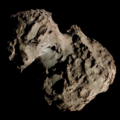C/1997 L1 (Zhu–Balam)
Comet Zhu–Balam, formally designated C/1997 L1, is a non-periodic comet first identified by David D. Balam on 8 June 1997, and originally photographed by Zhu Jin on 3 June 1997.[5][6] The comet is estimated at 10 kilometres in diameter,[5] with a period of approximately 36,895 years.[4] Until 1998, the comet was formerly known as Comet Xinglong,[2] until the International Astronomical Union (IAU) agreed to rename it Zhu–Balam after its first two discoverers.[7] OrbitGiven the orbital eccentricity of this object, different epochs can generate quite different heliocentric unperturbed two-body best-fit solutions to the aphelion distance (maximum distance) of this object. For objects at such high eccentricity, the Sun's barycentric coordinates are more stable than heliocentric coordinates. Using JPL Horizons the barycentric orbital elements for epoch 2015-Jan-01 generate a semi-major axis of 1,100 AU and a period of approximately 36,895 years.[4] References
External links
|
||||||||||||||||||||||||||||||||||||||||||||||||||||||
Portal di Ensiklopedia Dunia















